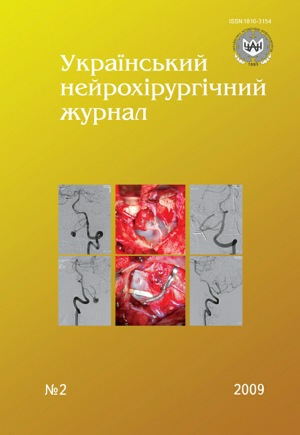Interbody fusion usе after discectomy in the thoracic spine
DOI:
https://doi.org/10.25305/unj.108640Keywords:
thoracic spine, hernia of the disc, interbody corporodesisAbstract
During the period from 1999 to 2009 at 16 patients, have been operated because of thoracic spine hernia, the interbody fusion was used. For patient’s functional status estimation a scale for patient with thoracic spine hernia status estimation (QTMR) was used. In the early postoperative period pain intensity decreased or pain has disappeared at 12 patients, motor disorders — at 15, conducting sensitiveness was improved — at 16, improvement of pelvic organs function was observed at 4 patients, reduction of segmental and radicular disorders — at 10, 8 patients could walk without assistance in the early postoperative period.
References
Хвисюк Н.И., Корж Н.А., Маковоз Е.М. Нестабильность позвоночника // Ортопедия и травматология. — 1984. — №3. — C.1–7.
Цивьян Я.Л., Мотов В.П. Аллопластика межпозвонковых дисков в эксперименте // Вопросы патологии позвоночника, травматологии и ортопедии. — Новосибирск, 1965. — С.28–30.
Ahlgren B.D., Herkowitz H.N. A modified posterolateral approach to the thoracic spine // J. Spin. Disord. — 1995. — V.8, N1. — P.69–75.
Cerillo A., Carangelo B., Bruno M.C. et al. Paravertebral retropleuric microsurgery approach to the treatment of thoracic disc herniation. Personal experience and consideration of unsatisfactory results / J. Neurosurg. Sci. — 2002. — V.46, N3–4. — P.135–142.
Cloward R.B. The treatment of ruptured intervertebral discs by vertebral body fusion // J. Neurosurg. — 1953. — V.10. — P.154.
Delfini R., Di Lorenzo N., Ciappetta P. et al. Surgical treatment of thoracic disc herniation: a reappraisal of Larson’s lateral extracavitary approach // Surg. Neurol. — 1996. — V.45, N6. — P.517–522.
Dickman C.A., Rosenthal D., Regan J.J. Reoperation for herniated thoracic discs // J. Neurosurg. — 1999. — V.91, suppl.2. — P.157162.
Fessler R.G., Sturgill M. Review: complications of surgery for thoracic disc disease // Surg. Neurol. — 1998. — V.49, N6. — P.609–618.
Fujimura Y., Nakamura M., Matsumoto M. Anterior decompression and fusion via the extrapleural approach for thoracic disc herniation causing myelopathy // Keio J. Med. — 1997. — V.46, N4. — P.173176.
Hamburger C. Modification of costotransversectomy to approach ventrally located intraspinal lesions. Preliminary report // Acta Neurochir. (Wien). — 1995. — V.136, N1–2. — P.12–15.
Lin P.M. Posterior lumbar interbody fusion technique: complications and pitfalls // Clin. Orthop. — 1985. — V.193. — P.90–102.
Maiman D.J., Larson S.J., Luck E., El-Ghatit A. Lateral extracavitary approach to the spine for thoracic disc herniation: report of 23 cases // Neurosurgery. — 1984. — V.14, N2. — P.178–182.
Rossitti S. Modified lateral approach for surgery of thoracic disk herniation. Technical note // Arq. Neuropsiquiatr. — 1994. — V.52, N2. — P.227–230.
Sagiuchi T., Iida H., Tachibana S. et al. Idiopathic spinal cord herniation associated with calcified thoracic disc extrusion — case report // Neurol. Med. Chir. (Tokyo). — 2003. — V.43, N7. — P.364368.
Schiffman M., BrauS.A., Henderson R., Gimmestad G. Bilateral implantation of low-profile interbody fusion cages: subsidence, lordosis, and fusion analysis // Spine J. — 2003. — V.3, N5. — P.377–387.
Young S., Karr G., O’Laoire S.A. Spinal cord compression due to thoracic disc herniation: results of microsurgical posterolateral costotransversectomy // Br. J. Neurosurg. — 1989. — V.3, N1. — P.31–38.
Downloads
Published
How to Cite
Issue
Section
License
Copyright (c) 2009 E. I. Slinko, A. M. Zolotoverkh, A. I. Ermolyev

This work is licensed under a Creative Commons Attribution 4.0 International License.
Ukrainian Neurosurgical Journal abides by the CREATIVE COMMONS copyright rights and permissions for open access journals.
Authors, who are published in this Journal, agree to the following conditions:
1. The authors reserve the right to authorship of the work and pass the first publication right of this work to the Journal under the terms of Creative Commons Attribution License, which allows others to freely distribute the published research with the obligatory reference to the authors of the original work and the first publication of the work in this Journal.
2. The authors have the right to conclude separate supplement agreements that relate to non-exclusive work distribution in the form of which it has been published by the Journal (for example, to upload the work to the online storage of the Journal or publish it as part of a monograph), provided that the reference to the first publication of the work in this Journal is included.









